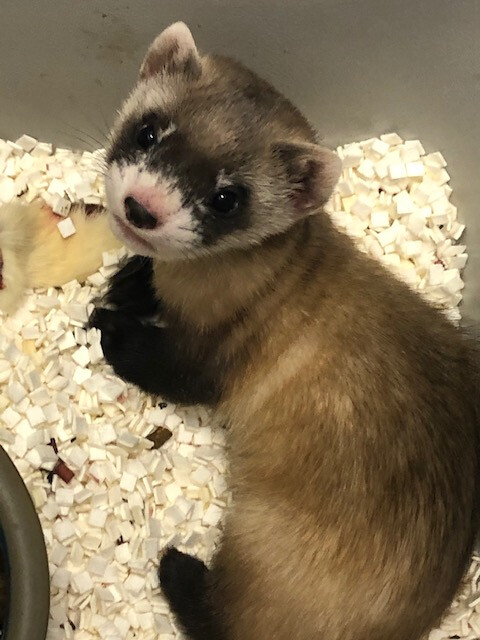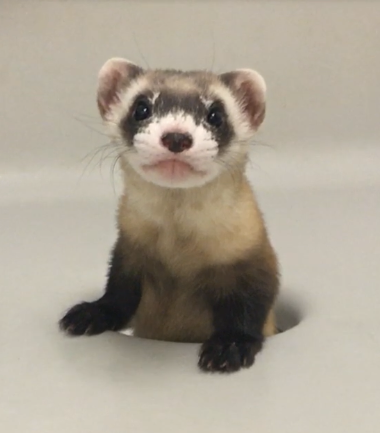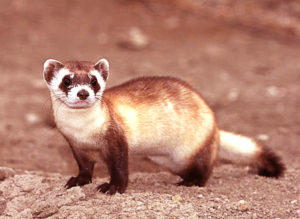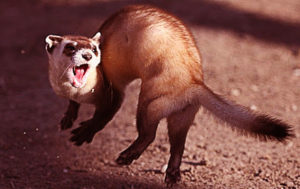Updated February 2021.
In February 2018 we wrote about a resurrection effort to bring the then endangered black-footed ferret back from the brink of extinction in western U.S. This effort was undertaken by the U.S. Fish and Wildlife Service, with assistance from Revive & Restore and partners ViaGen Pets & Equine, San Diego Zoo Global and the Association of Zoos and Aquariums.
On February 18, the U.S. Fish and Wildlife Service announced announced the successful cloning of a black-footed ferret, introducing the world to a 38-day-old black-footed ferret kit “Elizabeth Ann” cloned from cells of a female ferret that died in 1988.


Cells from ferret, “Willa” were preserved by freezing, and when somatic cell nuclear transfer (SCNT) became a possibility, Willa’s cells were used to create Elizabeth Ann, the kit born just over one month ago.
Before Elizabeth Ann’s birth there were upwards of 1,000 black-footed ferrets alive in the western U.S., but they were all descendants of just 7 ferrets, and thus genetically very similar.
Analysis of Elizabeth Ann’s genome has revealed more than three times the genetic variants found in the existing wild U.S. ferrets. This means that if she is able to reproduce, her contribution to the genetic diversity of wild ferrets would be huge.
Interested in learning more about ferrets and the challenges they’ve faced in surviving and thriving in the wild? Below is our original 2018 blog with those details. Don’t miss the video clip of a young black-footed ferret doing the “weasel war dance” (below).
About the BFF (Black-Footed Ferret)
The black-footed ferret, Mustela nigripes, is a member of the family Mustelidae, which includes mink, badger, marten, fisher, polecat and wolverine (of course domestic ferrets are also members of this family). Like mink and other members of the mustelidae, bff are long, slender animals that average 18 to 24 inches in length. Black-footed ferrets weigh 1½ –2½ lbs. Female ferrets are “jills”, males are “hobs” and juvenile ferrets are “kits”. The average life span of a black-footed ferret in the wild is 1–3 years.

Habitat
Black-footed ferrets are native to central North America and found only on this continent mainly in the western and southwestern US.
The BFF Problem?
Food source and habitat are tied in a complicated package for this tiny weasel. Black-footed ferrets exist in open grasslands and subsist almost exclusively on prairie dogs, who also make grasslands their home.
Prairie dogs are known to carry the plague bacterium, Yersinia pestis. This is the bacteria responsible for the Black Plague that killed millions of people along the trade routes from China to Europe beginning in about 1300. An earlier plague pandemic is estimated to have killed 25 million people around 541AD, and there have been subsequent pandemics with many millions of deaths globally, extending into the 20th century. Yersinia pestis is a deadly pathogen.
The culprit for such successful transmission of plague bacteria is the flea, which bites rodents (historically rats which carry plague bacteria), then bites and spreads the bacteria to humans.
Why plague bacteria seem to exist in prairie dogs with low or no mortality at times, and with very high mortality at other times, is currently not well understood, but during prairie dog endemic plague, entire villages can be wiped out. Some plague episodes with a high prairie dog mortality may be connected to particular weather conditions, but the phenomena affecting plague bacterium mortality is currently not well understood and in need of more research.
You can find a wealth of plague information at the Centers for Disease Control web page.
In addition, this blog, promegaconnections.com has seen a number of well-written blogs on various aspects of plague, including modern and recent incidents.
What is known is that plague kills black-footed ferrets and their main source of food, prairie dogs.
Another problem for black-footed ferrets is that grasslands are becoming more and more popular for cattle grazing, adding pressure to both prairie dogs and black-footed ferrets by decreasing the size of available habitat. Furthermore, it is legal in a number of western states to hunt prairie dogs. What’s bad for the prairie dog is bad for black-footed ferrets.
Black-Footed Ferret Extinction-Almost
According to the Wikipedia page on the black-footed ferret :
“It was declared extinct in 1979 until Lucille Hogg’s dog brought a dead black-footed ferret to her door in Meeteetse, Wyoming in 1981. That remnant population of a few dozen ferrets lasted there until the animals were considered extinct in the wild in 1987. However, a captive breeding program launched by the United States Fish and Wildlife Service resulted in its reintroduction into eight western states and Mexico from 1991 to 2008.”
Upgrade to Endangered
In 2008, the black-footed ferret was upgraded to the endangered species list. The US Fish and Wildlife Service black-footed ferret reintroduction program has been successful, with an estimated 1,000 wild-borne adult ferrets in South Dakota and Wyoming, these efforts are on-going to increase bff populations.
Plague Interruption Program
Several efforts have been used to interrupt the plague cycle in prairie dogs. Flea-killing dust has been sprinkled at the entrance to prairie dogs burrows. Spreading of insecticidal dust is of course a time- and labor-intensive process that can be interrupted by certain types of weather.
A human plague vaccine was previously used by the US military. This vaccine is not currently in production for humans, but has been found effective for prairie dogs. How do you vaccinate a prairie dog? Apparently peanut butter is irresistible to them, and clever individuals have devised a vaccine-in-a-cookie using peanut butter. These tasty pellets can be dropped by helicopter over prairie dog villages, and the edible vaccination has been shown to protect prairie dogs later exposed to plague bacteria.
Some black-footed ferrets that were bred and raised in captivity have been successfully vaccinated by injection against plague, but this practice doesn’t work well for wild populations. And you’ll recall that black-footed ferrets eat prairie dogs almost exclusively: no peanut-butter-vaccine-cookies for ferrets.
Creating a Better Black-Footed Ferret?
Then somewhat more 21st century idea was proposed to help strengthen and ensure recovery of black-footed ferret populations. An initiative called Revive & Restore was created by Stewart Brand and friends. The Revive & Restore plan is essentially to use modern-day genetic engineering capabilities to bolster populations that are threatened, by improving the genotype of the affected species.
In the case of black-footed ferrets, the small number of ferrets available for breeding to re-establish bff in the wild resulted in inbreeding. Inbreeding can caused decreased genetic vigor, higher incidence of genetic abnormalities in offspring and even lower number of kits.
This 2015 paper from the Journal of Heredity explains the plan that scientists, working with Revive & Restore propose: “A Road Map for 21st Century Genetic Restoration: Gene Pool Enrichment of the Black-Footed Ferret”.

Simply, somatic cell nuclear transfer (SCNT) can be used to clone individuals without taking genetic material from a germ cell. Instead, nuclear DNA content can be collected from another cell type, such as skin cells. The authors of this paper suggest performing the DNA transfer technique using material from non-native domestic ferret.
This work is a really interesting proposal for how SCNT and DNA from domestic ferrets could make a better ferret. This work requires permission by the USFWS and other federal agencies.
One final note on BFF. As a fan of prairie dogs and their highly social, family-oriented lifestyle, it’s taken me a little while to warm up to black-footed ferrets and their prairie dog-consuming lifestyle. If you feel this way as well, here is a video that will help you “warm up to” the black-footed ferrets.
Blog updated February 22, 2021, April 12, 2024
